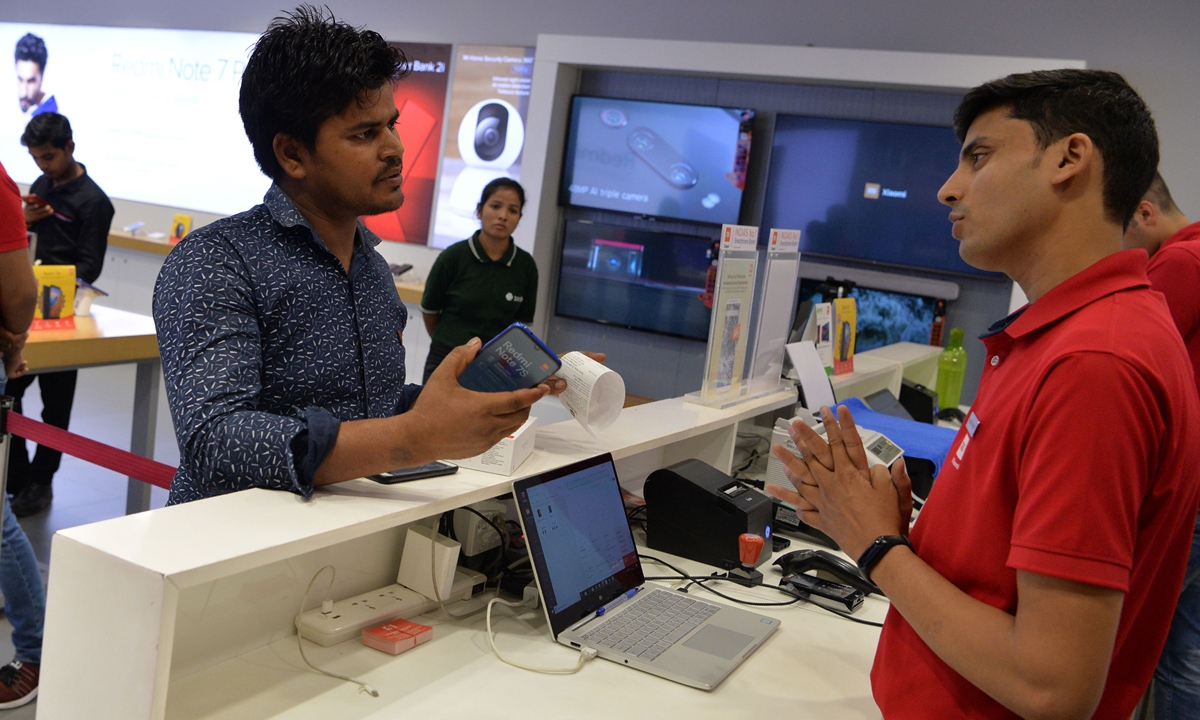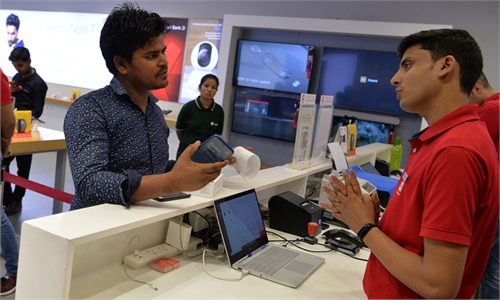COMMENTS / EXPERT ASSESSMENT
China-India cooperation in digital economy has great potential but with conditions

In this photo taken on August 20, 2019, a salesman speaks with a customer after he purchased a new smartphone made by Xiaomi at a Mi store in Gurgaon, India. Photo: VCG
Several international consultancy firms found that Indias digital economy is growing at one of the fastest rates in the world and its development journey is following Chinas. From a rational perspective, as two of the largest emerging economies with the most internet users in the world, China and India have great potential in boosting cooperation in the digital economy, but with conditions.
According to latest statistics, bilateral trade between the two countries increased by 30 percent in 2021 and reached a historic high of $125.6 billion. It has proven that no matter how much India media hype the so-called boycott of goods, trade between China and India still saw great vitality.
In 2021, Indias imports of integrated circuits from China grew by 147 percent, while the imports of laptops and PCs grew by 77 percent. Aside from that, the Indian smartphone market experienced a strong recovery with annual shipments reaching a record 162 million units, in which China's Xiaomi took the lead by shipping 40.5 million units. Data suggests Indias great demand for infrastructure goods in the digital economy and China can provide sufficient supply, proving that the Chinese and Indian markets are highly complementary.
Indias digital progress has further accelerated amid the pandemic as consumers relied on technology to meet daily needs, from purchasing daily necessities and accessing online learning, to health services. It is said the Indian digital economy journey mirrors Chinas. The research results showed that current Indian digital economy development is just like Chinas seven to eight years ago.
As a comparatively mature digital market, China does have great experience to share with India. Chinese tech and internet enterprises have also invested in the Indian market. Alibaba and Tencent, for instance, have invested in the fields of fintech, e-commerce, and online entertainment, among others. A good example is Paytm, the biggest Indian mobile payment company invested in by Alibaba, finished its listing in the Mumbai stock market. The success of Paytm will transform Indians payment modes and the maps of e-commerce.
However, looking back to the past two decades, Chinese investments were not that welcome by the Indian market. Chinese direct investment in India accounted for a mere 0.51 percent of total FDI in India. And these investments concentrated in technology start-ups. It is not hard to see New Delhis protectionist attitude toward Chinese investment and sometimes extreme cases do happen, such as the abrupt, unwarranted tax inspection by Indian authorities against Chinese companies, or the sudden abandonment of Chinese apps in the Indian market.
Some Indian officials said these moves would protect Indias national enterprises and industries. Unfortunately, most of the market share was taken up by US and other Western rivals. These sort of retrograde trade policies, to some extent, are short-sighted and even damaging Indias commercial reputation globally. According to a UN report, FDI flows to India slipped by 26 percent in 2021. If India abandoned its economic nationalism measures, the future would be very different.
If we take a broader view at Sino-Indian cooperation in the field of the digital economy, it is clear that China and India share a likely vision. On the one hand, top Chinese leaders have long attached great importance to the development of digital technology and the digital economy.
On the other hand, the Indian Prime Minister, Narendra Modi, proposed the Digital India initiative in 2015 with a vision to transform India into a digitally empowered society and knowledge-based economy, especially to develop secure and stabilize digital infrastructure and deliver universal digital literacy.
According to a White Paper on China's Digital Economy Development (2021), the digital economy accounts for 38.6 percent of Chinas GDP. Meanwhile, the Indias digital economys contribution to GDP is expected to reach 20 percent in the next five years. It is apparent that the digital economy is the driving force for economic growth.
Just like what was proposed in the first Sherpas meeting of the BRICS in January 2022, the digital economy is one of the eight main fields for further cooperation among members. That means the platform for cooperation is ready. Whether or not to grasp the historical opportunity depends on the decision from the Indian side. If New Delhi shows sincerity, the cooperation in digital economy will likely be a close link between two giants. A Chinese idiom may be helpful for Chinas Indian friends - harmony brings wealth, while peace breeds success.
The author is a research fellow at Centre for BRICS Studies, Communication University of China and a distinguished research fellow at the Centre for South Asian Studies, Xiangtan University. opinion@globaltimes.com.cn



